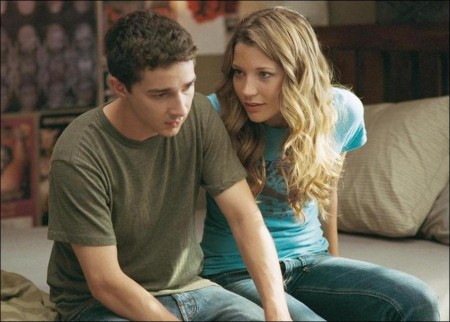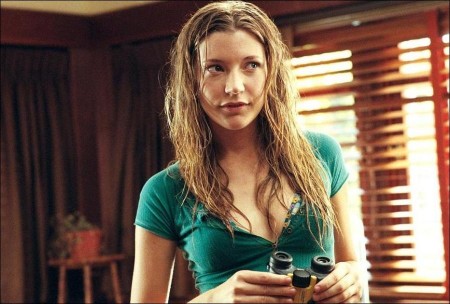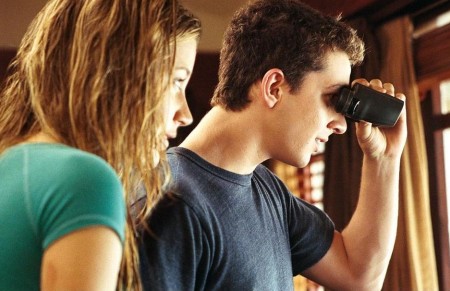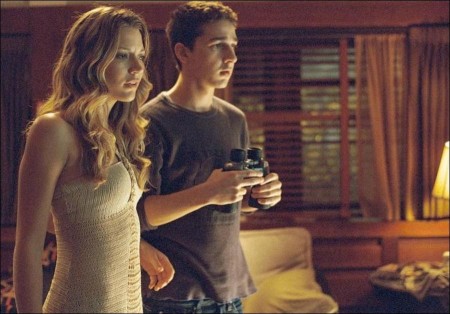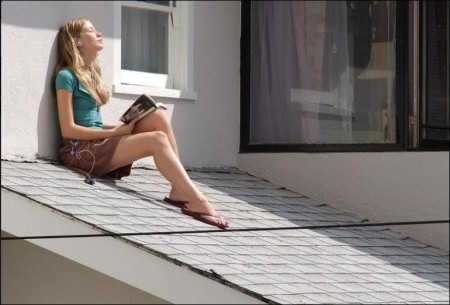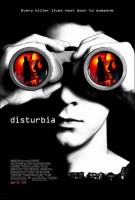Tagline: Every killer lives next door to someone.
Kale (Shia LaBeouf) has a life most teenagers would envy. He spends his days endlessly playing video games, surfing the net, eating junk food and watching cable. He has complete free reign of the house, and a beautiful young hottie named Ashley (Sarah Roemer) has just moved in next-door.
There’s only one problem – he’s not allowed to leave the house. Kale’s under court-ordered house arrest for three months, and if he takes one step beyond a 100-foot perimeter of the house, his next confinement will be in a real prison. And jail cells don’t have video games or cable.
Life hasn’t always been like this for him. A year ago, Kale and his mom (Carrie-Anne Moss) and dad were a tight-knit, happy family. Then his father was killed in a car accident, for which Kale feels somewhat responsible. The trauma has had long-lasting psychological effects. The once outgoing young man is now shut down and withdrawn. When an insensitive teacher brings up his father, Kale loses it and punches him out. Only the intercession of his mother kept him out of jail.
Now he’s going stir crazy in his own house while his mother tries to keep things together by working day and night. As the walls start to close in, Kale starts to notice the world outside. With some secondhand surveillance equipment he begins spying on his neighbors, most prominently Ashley, who soon catches on to him. To his surprise however, she becomes interested in his stakeout hobby. What starts out as a game turns deadly serious when Kale and Ashley begin to suspect that one of their neighbors (David Morse) may be an elusive serial killer. But who’s going to believe them? It may just be their overactive imagination. Or they may have stumbled across a secret that might cost them their lives. After all, even killers have to live next-door to someone…
About the Production
For writer Christopher Landon, the genesis for “Disturbia,” a suspense thriller in which the upscale homes and manicured lawns of suburbia could be the perfect hiding place for a serial killer, arose from a visit to his sister’s home “deep in the `burbs of Los Angeles’ San Fernando Valley. “Everyone pretty much considers suburbia as something that is idealistic and beautiful… but it’s always kind of given me the creeps,” Landon says. “One night, as I was driving home from my sister’s place, this idea just popped into my head – a story about a kid who is stuck in his house and begins to notice bizarre things happening across the way. He eventually comes to suspect that his neighbor is a serial killer.”
For Landon, the seeming calm of suburbia produces a “forest for the trees” effect, in which people go about their lives oblivious to the circumstances – benevolent or dangerous – surrounding them. “I think that many people who live in these neighborhoods fall into a daily routine and, for the most part, don’t really know their neighbors very well.”
Such is the case with Kale, the 17-year-old at the center of “Disturbia.” Until the automobile accident that killed his father, life with his family was the typical suburban dream. They were a happy, nuclear unit, ensconced in a beautiful two-story Craftsman bungalow. In the year since his father’s death, however, that dream had disintegrated. When the troubled Kale is challenged at school by one of his teachers, he lashes out, punches the instructor and winds up in court. While he is spared juvenile detention, Kale is sentenced to house arrest and must wear an ankle bracelet that will summon the police if he ventures more than 100 feet from his front door.
The upside of having the house to himself all day long quickly wear thin and Kale turns his attention to his next-door neighbors. He and his best friend Ronnie engage in a game of “I spy,” making note of the comings and goings of the residents around them. Curious patterns emerge and the glossy suburban façade begins to tarnish. Idiosyncrasies come to light and personal affairs are revealed. When Kale’s new neighbor, the beautiful Ashley, discovers his little game, she decides to join in on the spying.
But they soon make an unsettling discovery that turns the whole game deadly serious. “In general, we don’t really pay close attention to what’s around us, because we’re too busy with our lives,” observes Landon. “But Kale is now in a position where he really has nothing else to do but notice. And once he starts watching, he begins to see some unsettling things and he has to wonder if it’s just his imagination running wild, or is there more out there than meets the eye?”
For the screenwriter, one of the more compelling aspects of this kind of thriller was not the “is he or isn’t he a serial killer?” angle, but the personalities of the ragtag troupe of spying teenagers who are at the heart of the story. “In these types of films, you usually have someone like a Harrison Ford-type chasing down the bad guys. But these kids are not your classic hero types,” Landon notes. “Kale’s just this kid with time on his hands who realizes `I have an entire reality TV show happening all around me.’ In the process, he stumbles on a really dark and terrifying character in the show.”
It was exactly Landon’s voyeuristic exploration combined with a varied stylistic tone that ranged from almost comic to nail-biting that appealed to Montecito Picture Company producer Joe Medjuck. “All films are essentially voyeuristic in some way,” Medjuk suggests. “But there are some great ones that are actually about people observing, looking at things. There’s Antonioni’s `Blow Up,’ Michael Powell’s `Peeping Tom,’ Hitchcock`s `Rear Window,’ Coppola’s `The Conversation,’ along with several others. They’re about someone who’s looking at something, sometimes with a camera, sometimes not. And it’s fascinating, because it makes us especially aware that we’re always voyeurs when we’re in the cinema. It’s an even stronger sensation when you have the point-of-view of someone who is spying on someone else. Kale’s looking at the girl next-door swimming and spying on the guy behind him because he thinks the guy might be a killer. He’s discovering things about the neighbors he probably shouldn’t know. And when people are not aware they’re being watched, they do things differently – behave differently – and that’s fascinating.”
Thanks to constant advances in contemporary electronic technology, it’s become increasingly easy to watch other people – stealthier surveillance equipment like DV is augmented with the ever-present camera cell phone — all of which allow Kale access to what’s going on beyond his restricted 100-foot perimeter from the “control center” inside his home.
For blockbuster filmmakers and Montecito Picture Company principals Ivan Reitman and Tom Pollock (who serve as executive producers on the film), “Disturbia” was somewhat of a conscious stylistic departure. “Most of the films we’ve produced have been broad comedies, usually with teenagers, or at least people behaving like teenagers, at the center, films such as `Old School’ and `Road Trip,’” Reitman mentions. “While this one has high school students as its main characters, it is a thriller… with some attitude. So it’s a little bit different.”
Adds Pollock: “We immediately recognized the story’s potential when we first read the script. What makes Kale and his friends interesting is the fact that we recognize them, and they wouldn’t normally be considered your typical heroes. This kid’s under house arrest, his best friend is a little eccentric, and his potential girlfriend is a misunderstood beauty. Set them down in the center of a thriller and we, as audience members, have someone to go along with.
For director D.J. Caruso, while “Disturbia” could not really be considered a career departure (among his previous credits are the Angelina Jolie/Ethan Hawke thriller “Taking Lives”), it speaks to a different audience than his previous films. Caruso says, “My movies have tended to be a little bit more focused on characters with addictions or problems…or, in one case, fighting a serial killer. So this film presented a challenge – I grew up loving thrillers as well as films by people like Cameron Crowe and John Hughes. `Disturbia’ has elements of both those kinds of films, and these are avenues I hadn’t been able to previously explore as a filmmaker.”
It didn’t hurt that one of the entertainment industry’s giants had personally phoned him about the project. “I was directing the season premiere of `The Shield,’ and my phone rang… and it was Steven Spielberg,” says Caruso. “He said he had a script he wanted me to read that he thought I’d be perfect for. I read it as soon as I got it and came in and met with him. That’s how it all started, though I have to admit, for a minute there I thought it was a friend playing a practical joke.”
Caruso’s multifaceted career was one of his greatest strengths, according to producer E. Bennett Walsh, who found that his experience wearing other hats came in handy on “Disturbia.” “D.J.’s a great partner. He’s always thinking of what’s best for the story, and how to maximize it in front of the lens,” he says. “Because he has also been a producer, he has the skill set to know what it takes to get a show together while also being true to the creative elements. And when you think of what a film is -basically one shot after another to tell a believable story when we’re shooting, building one block after another.”
The Neighborhood Watch
For the role of Kale, the troubled teen whose daily routine now includes spying on the neighbors, the filmmakers were looking for an actor who had the stamina to sustain throughout the film (his character is in nearly every scene) and to bring out all the dimensions and nuances of a teenager’s personality. That meant he had to be smart, funny, a little bit dark, a little bit quirky and, ultimately, have the ability to take charge and act heroic. The search came to a quick resolution when one Shia LaBeouf walked into the audition room… and, more or less, walked out with the part: LaBeouf has managed to bridge the tricky career breach between being a child actor (with an immensely popular television series under his belt) and a young leading man (he’s headlined several films, including the upcoming blockbuster “Transformers” for director Michael Bay and producer Steven Spielberg).
The director says, “It was a tough casting choice because Kale is pretty much in every scene. And we had had discussions about Kale being relatable, not that perfect-looking, cover model type. I mean, for me, some of my favorite actors growing up were Sean Penn and John Cusack. Shia is a charming intellectual, a really good-looking guy. Halfway through Shia’s reading, though, I just knew he was this guy and as soon as the door closed, I told the casting director, `That’s him. We found him.’”
Caruso admits he wasn’t familiar with LaBeouf’s previous work even though his children are fans of his show, “Even Stevens.” But he found him to be a great natural actor, whose “realness” comes across onscreen, which was essential for his central character, someone the audience could identify with (flaws and all) and cheer on. In addition, he was able to handle all the plot turns inherent in the script. (Interestingly, LaBeouf notes that Caruso’s compelling “The Salton Sea” is one of his favorite films, and that he auditioned for “Disturbia” primarily for the chance to work with him).
“I think the different tones in `Disturbia’ come from our everyday lives,” says Caruso. “There are moments in life where you’re laughing and, a minute later, you’re scared out of your wits. That’s what makes the movie work, and much of that is due to Shia’s talent. He has that balance. In working with him, I discovered that if the moment felt real he was okay about exploring all these different avenues.”
For LaBeouf, Kale was an attractive character to create. “When Kale loses his father, his whole world changes,” he says. “He becomes a dark, somewhat closed-off human being. Because his mom is dealing with the same pain, she’s not available, so Kale turns into this out-of-control kid under house arrest. It’s kind of like dangling meat in front of a dog. In jail, you’re locked away from the world, but on house arrest, the world is tantalizingly out there in front of you. And on top of that, he may be living across from a killer.
“The question of whether it’s true or not,” he continues, “becomes his ultimate focus… and the windows of his house become his world. He doesn’t want to deal with his feelings because the pain is too intense. So, he starts looking out and finding himself outside. He begins to explore other people’s pain as he views relationships unfolding. While doing that, he finds someone he thinks is a murderer.”
Though technology becomes a primary factor in Kale’s campaign to prove that what he thinks he has seen is true, it also impacts n Kale’s isolation and loneliness. “YouTube and MySpace have supposedly revolutionized communication for kids,” LaBeouf mentions. But I’m not so sure. They always said cell phones would bring people closer together, but they really take you farther away, especially because some people prefer to text rather than have a conversation. Kale is growing up in the middle of change in the way we communicate. Streaming video clips and media of all sorts are available to him, and they become his connection to the outside. Technology enables him to become the ultimate voyeur and that informs his whole being.”
Someone who is eager to escape notice in Kale’s new voyeuristic world is Mr. Turner, the elusive loner across the way. On the surface, Turner appears to be the ideal neighbor. The lawn and exterior of his home are manicured. His trash never piles up. He’s quiet and keeps to himself – that is until Kale and his friends start spying on him and witness some potentially disturbing behavior.
To portray Turner, the “Disturbia” filmmakers turned to the versatile and prolific David Morse, whose performances have run the gamut from the ideal father (“Contact”) to the caring doctor (television’s “St. Elsewhere”), the prison guard (“The Green Mile”) to the menace in Samaritan’s clothing (on the Broadway stage in “How I Learned to Drive”).
For Caruso, although Turner is complex on paper, his character is rather simple: He’s an unassuming guy who loves his house, and when Kale infringes on his somewhat twisted little paradise, all he can he do is try and preserve the peace…even if it ultimately leads to violence.
“I had met David years ago on the set of `The Green Mile’ because a good friend of mine, Frank Darabont, wrote and directed it,” says Caruso. “I’d always admired him as an actor. I thought `St. Elsewhere’ was one of the best shows on TV, and a lot of that was due to the quiet, subtle character he played.
That’s the level of commitment he brought to this role as well. With every take, he made small, well thought-out changes. David’s a very daring actor, but in a very quiet way, the acting equivalent of Cal Ripkin. He’s a solid guy and he’s present every day. And you don’t even fully appreciate how great he is until you’re in the cutting room.”
Morse looked forward to getting under the character’s skin and creating an inner logic for him that would explain his sociopathic behavior. “I’ve played a few questionable characters, and Turner is one of those guys who can go one way or another,” he says. “I like walking that fine line and trying to find the integrity of that kind of person, that inner life that makes you wonder.”
Believe it or not, says Morse, Turner may be similar to his neighbor Kale. For instance, they’re both shy when it comes to dealing with others (the opposite sex in particular). “Turner describes himself as being shy. He’s got this beautiful house, a nice car, everything you might want for an ideal life but he doesn’t have relationships,” explains Morse. “No wife, no kids. So he’s out there seeking something. And that makes him vulnerable, which is something I like about him.”
Physically, Morse is imposing, standing six-feet, four-inches tall. That stature belies a natural charm, which creates a compelling dichotomy. Producer Medjuck offers, “He exudes charm on film. But when he becomes quiet, he can be a little scary because he has such a strong presence. Also, he’s working with people who are physically smaller and younger, which makes him a great potential bad guy.”
Morse approaches his characters methodically and chose to remain elusive on set, not taking meals or socializing with other cast members. His deep character work also contributed to a truly believable fight scene between Turner and Kale, LaBeouf recalls. “We were shooting the fight scene, and since the camera was so close and the set was restrictive, we didn’t use stunt doubles. We wanted the audience to be up in there. During the shoot, the scene went unbelievably well-we pushed farther and farther, and it was amazing. I found out later that he broke three fingers during that scene, but he didn’t mention it, because he didn’t want his character to seem weak.”
As far as his other neighbors go, Kale has a wide assortment to choose from – an unfaithful husband, a pampering dog owner, a taciturn loner… and every high school senior’s ideal girl, Ashley, a new arrival on his block. The director describes Ashley as “the breath of fresh air, the beautiful girl that moves in next-door. While the earliest draft of the script described her as basically the hot girl with the great body and beautiful smile, as the story was developed her character become more multi-dimensional. There’s a lot going on in her house and life, too. And she becomes the object of Kale’s desire. “Everything is going bad for Kale until she moves in,” observes Caruso. “So she signifies hope. Part of Kale’s story is that he’s always looking outside himself for answers – and through every window is a different movie.
The couple across the street are in a comedy about infidelity. Turner and his suspicious goings-on are out the back window of his dad’s study. And from his bedroom window is Ashley, the ultimate dream girl, right out of `Fast Times at Ridgemont High’ or `Summer of `42.’”
Relative newcomer Sarah Roemer was cast as Kale’s “it” girl, Ashley. “Ashley’s from the city, and her parents-who are having problems themselves-have moved to the suburbs, which she didn’t really want to do,” says Roemer. “Since she has a lot of issues with her mother, she desperately wants to get out of the house whenever she can. Then she sees Kale, who is also stuck in his house, although under very different circumstances. They both feel trapped, and that leads to a connection. Yeah, there’s physical attraction, but it’s almost more of an inner connection that bonds them… at first, anyway.”
Despite Ashley’s interest in Kale as a kindred spirit, he still feels the need to impress her. Screenwriter Landon found that to be part of the charm of the relationship. “Kale tries to be all cool, but he’s not a jock. He’s clearly different. Even before his house arrest, he didn’t go to keggers, he didn’t hit cool parties. But he’s trying to be cool even though she can see through that. It may even be what she likes about him.”
For Kale’s mother, Julie, the filmmakers nabbed “The Matrix’s” iconic Carrie-Anne Moss. And while audiences are familiar with her on-screen persona as someone who kicks ass, her role in “Disturbia” called for a different set of acting skills, deep maternal affection combined with a strong dose of tough love. “If Ashley is the dream neighbor, Carrie-Anne as Julie is sort of the dream mom,” says Caruso. “While she’s age-appropriate to be a mom-and is in real life-she’s also still amazingly beautiful and a superb actress with a warm, motherly instinct, qualities she brought to the set every day.”
“When I first read the script, I loved the fact that I would be supporting another person’s journey, another actor’s journey,” says Moss.“It appealed to me as a performer, as a woman, and also appealed to me for my life. What really drew me was Kale’s journey, and what the actor would be going through-I wanted to watch it. Shia did such a great job. I think we’re all a little bit in awe of him. He’s very special.”
What would a journey for a teen under house arrest be without a sidekick, preferably someone on the eccentric side, a bit of a cut-up, a slacker with brains. Enter Aaron Yoo as Ronnie, Kale’s (somewhat reluctant) legman, whom he enlists to wander into dangerous places where Kale cannot go because it’s too far beyond the perimeters of his house.
The director reasons that since Kale and Ronnie were best friends prior to Kale’s sentencing, Ronnie is, by association, also under house arrest…at least, empathically. While Kale has a tendency toward dark, sullen moods, Ronnie serves as a balancing influence with his jovial manner, sunny outlook and overall innocent demeanor. “Almost from the beginning-from the character breakdown to meeting D.J.-everyone just kept saying, `Hey, it’s you, only on paper,’” laughs Yoo. “I was, like, `Great, but I don’t really know how to prepare to play me on paper.’ While I might have tended to push the comedy, D.J. was always about building the friendship between my character and Kale, and letting the comedy follow. I mean, if you think about it, I’m playing a guy who’s worried about his friend maybe going crazy because of his dad’s death, so the comedy comes from Ronnie trying to deal with that in his own way, a childish, ADD kind of thing — comic quips, sarcasm and just tripping over things, physically or mentally.”
The alchemy created by the ensemble of actors impressed LaBeouf and, because of the high comfort level established on set by their director, the group began to insinuate their scripted alter-egos with subtle changes. “On paper, it’s a pretty good story, but D.J. is obsessed with character and when you have that kind of director you are able to branch off and go in different directions, which make the script really come to life,” says LaBeouf. “That’s what made me really want to do the film.”
A Craftsman with Great Views-Must See to Appreciate
With a relatively short production schedule, the filmmakers were on high alert from the get-go. Essentially, they were confronted with a film that is primarily set on one street and largely within one home on that street. As they began pre-production on “Disturbia,” however, they quickly found that even “one street/one home” movies can be challenging. “It sounded like a very simple movie to shoot,” says Caruso. “A boy has a tragedy in the beginning and then gets sentenced to house arrest. From then on he’s basically in his home where he starts looking out at his neighbors. But as we began figuring out the logistics of what we needed each house in the neighborhood to be, we eventually ended up with a backyard in one city, a front yard in a different city and interiors built on soundstages. It was a lot more difficult than I’d first imagined.”
What proved particularly helpful to the director in maximizing his shooting days was his alliance with production designer Tom Southwell. Caruso and Southwell’s relationship dates back to “Drop Zone” on which Caruso was handling the second unit. That experience proved so fruitful that when Caruso was about to direct his first film, “The Salton Sea,” he brought Southwell onboard as production designer. Southwell has continued to design every Caruso film since.
The question on “Disturbia” was, “What will our suburbia look like?” As Caruso notes, “There have been films with suburban neighborhoods made up of cookie-cutter houses, many of them in the `70s and `80s. But suburban neighborhoods have changed and we really wanted each house to have its own personality. For Kale’s house, we loved the idea of a Craftsman, like the ones you see in Pasadena [many of which are modeled on the Arts and Crafts bungalows of Charles and Henry Greene]. We felt like that style would be warm and inviting and, at the same time, it could be a scary, dark place when the movie turns into a thriller.
“The Greene & Greene architecture feels hooded, with the deep-set windows and doors, overhanging porches and other elements designed to keep out the sunlight,” continues Caruso. “So, it’s always much brighter outside and darker and cooler inside. For a voyeuristic movie, we liked having our lead character in the dark, looking out into the light.”
Producer Walsh adds, “Obviously, the big thing we had to look for was the neighborhood and the house. Everything takes place in that house. And there were certain needs in terms of the front of the house and the back of the house that led to a countrywide search.”
Neighborhoods in North Carolina and Georgia were explored as were areas in California and every studio backlot in town. The quest was complicated by the fact that the script called for certain specific characteristics in Kale’s home including second-story windows that look out onto the front, back and side yards, as well as a driveway (which separates Kale’s house from Ashley’s) and a backyard (that bordered on Turner’s yard). The major stumbling block proved to be finding the right backyard, since it entailed knocking on doors or, perhaps, hopping fences. But Caruso had an idea – a helicopter ride. “We had to go up in a chopper and actually start educating ourselves on different backyards since that was the quickest way to view them,” says Walsh. “That’s how we ultimately found what ended up being Turner’s backyard.”
The production split up Kale’s house into three locations: the front was in Whittier, California (with Ashley’s house right next-door); the back of the house was in Pasadena (a false “back” was built and a fence was erected between the façade and Turner’s house); and interiors, primarily Kale’s bedroom, his late father’s study and the first floor kitchen, which were constructed on soundstages on the Paramount Pictures lot. Any given scene might have to be filmed in three locations, and all the shots, of course, needed to match for continuity purposes.
To further distinguish the homes and provide subtextual “personalities,” Southwell and Caruso selected different color palettes for each. Turner’s was a cool blue, while Ashley’s home was a warm, inviting beige that glowed in daylight and included a large swimming pool built by the production. Kale’s home remained architecturally true to its Craftsman design, with its earthy tones of greens and browns.
Another problem in shooting on location was the use of Pasadena’s historic area. The city has strict civic codes, though somehow the production did manage to get permission to shoot for an entire week at night. Says producer Medjuck, “But we did it with a firm deadline hanging over our heads, so if anything went wrong, we weren’t going to be allowed to come back for an extra night. That put a certain amount of pressure on us.”
With Southwell and his team-set decorator Maria Nay and art director Douglas Cumming-expertly coordinating and dressing the existing locations (and the wholly created ones), the assembled suburb took on a life of its own, and the spaces themselves became characters. “The spaces reflect who our characters are,” says Moss, “because they are the settings of our lives. So in a way they themselves become characters. You look around and see the details and you feel the connections. It’s a subtle thing, but Tom was really able to capture a real, true quality in his work, which definitely impacted all our work. The spaces felt lived-in, as if you’d been over for dinner at a house just like this.”
Caruso and the design team went so far as to scout teenagers’ rooms to crib ideas and plug into the utmost in current teen bedroom reality – complete with chaos. As Southwell explains, “Parents allowed me to photograph the mess their teenagers had made, as well as all the kids’ personal touches. So there were posters, CDs, computers, books, pictures on the walls, clothes on the floor — an explosion of visual material. As we would go through these houses, D.J. would come over and whisper to me, `You know, I like that.’”
The verisimilitude also extended to the wardrobe created by Marie-Sylvie Deveau, continuing her collaboration with Caruso (Deveau previously costumed his “Two for the Money” and “Taking Lives”). The same attention to detail and character delineation was lavished on Kale’s clothes, his mom’s and those of their neighbors and friends. Kale and Ronnie’s clothes are comfortable, slacker/geek wear; Julie wears both casual and business attire; Ashley has a closet full of sun and party clothes; and Turner wore staid, unflashy apparel. When the film you’re making is about people observing, photographing and videoing other people, the role of director of photography becomes even more pivotal. That key slot was filled by Rogier Stoffers, whose atmospheric and award-winning cinematography has been utilized in a wide variety of films, both in the United States and abroad.
The partnership among the director, cinematographer and production designer was configured as a three-way street, with conferences on such issues as the multiple dressings and looks of the windows (through which much of the film is viewed) and the wall colors (which could be taken from bright to sinister with lighting adjustments). During meetings there were careful discussions about glass (antique, filtered, matte), wood (graininess, sheen, color) and window coverings (blinds, sheers, draperies), all in an effort to provide as much variety to the “eyes of the house” as possible, and to prevent (as Southwell put it) “people yawning the second and third time we go to the window.”
To provide further variety to the vantage points of Kale’s story, Caruso was intent on keeping the camera in motion, despite the fact that he was working largely in the interior confines of a single home. “D.J.’s very good with the camera in the sense that it’s almost always moving, even though we shot in a lockdown situation,” says producer Medjuck. “He’s very aware when we’re filming from someone’s point-of-view and whether it’s with the naked eye, through binoculars or a video camera. We actually ended up utilizing quite a few shots that were literally taken with a video camera. D.J. himself held the camera and swung it around multiple times, as if Kale were looking through it and filming across the way.”
Directing “Disturbia” was a guilty pleasure for Caruso, who notes, “Because I’m a filmmaker, I am in constant voyeur mode, whether I’m listening to a conversation or in a supermarket shopping. So this project, for me, was a catharsis of sorts. It felt good doing this because, basically, I feel that my whole life I’ve been watching and spying and capturing little moments between actors. So, in a way, I was able to put myself in Kale’s shoes, look over his shoulder and play out these voyeuristic fantasies in my mind, both as a filmmaker and as an audience member. I think that’s the attraction to this kind of movie. The audience always feels a little guilty for watching, too.”
The cast also found the experience somewhat of a guilty pleasure. Morse says “I used to watch people all the time. When I was in theater and nobody knew who I was, I would stand on the Boston streets sometimes for hours, even days, and just watch, and watch, and watch. I loved it. But as my face became familiar, it was a little harder to do. As soon as you make eye contact, it’s all over. The best place for me to observe people now is the New York subways, because nobody makes eye contact on the subway. So I can look at everybody and get away with it.”
It all comes back to watching, which for Kale can only be done out the windows of his house.Yet those views afford a fairly unsettling picture of suburban life. As Caruso sums it up, “You start watching your neighbors. You start studying their patterns.You start to imagine what things are happening in their homes and why. And even though it could all be innocent, it could also be that subversive thing that some of us believe is what is really going on in suburbia.”
Production notes provided by DreamWorks Pictures.
Disturbia
Starring: Shia LaBeouf, Carrie-Anne Moss, David Morse, Sarah Roemer, Kurt David Anderson, Elyse Mirto
Directed by: D.J. Caruso
Screenplay by: Christopher Landon
Release Date: April 13th, 2007
MPAA Rating: PG-13 for sequences of terror and violence, and some sensuality.
Studio: DreamWorks Pictures
Box Office Totals
Domestic: $80,209,692 (68.1%)
Foreign: $37,550,442 (31.9%)
Total: $117,760,134 (Worldwide)
